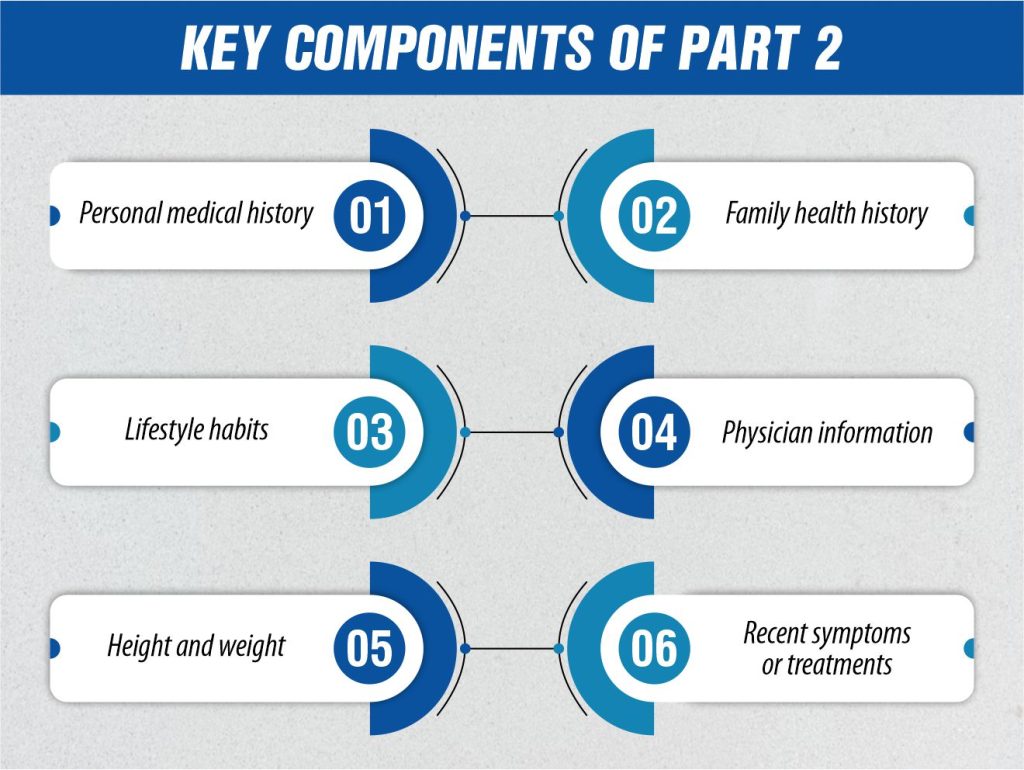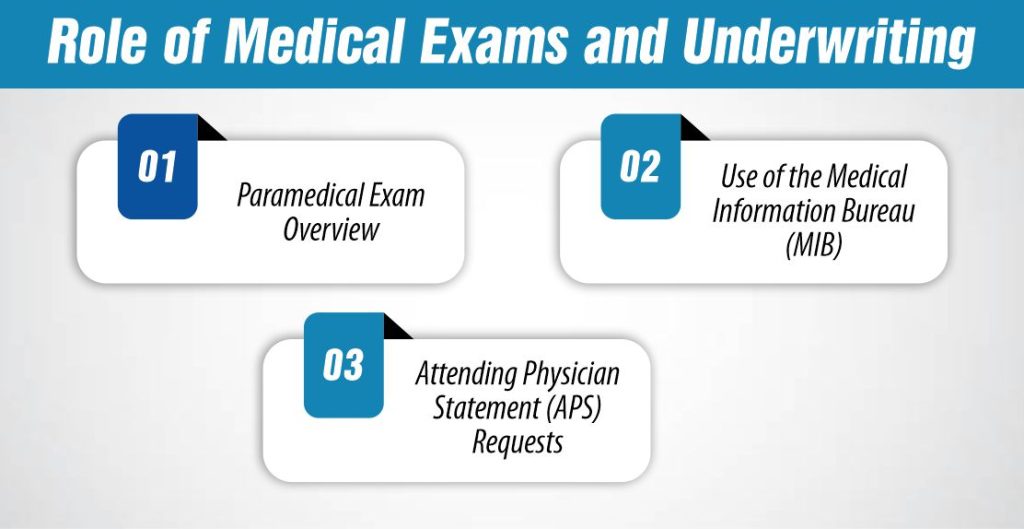Last Updated on: May 5th, 2025
Reviewed by Kyle Wilson

Applying for life insurance can feel overwhelming, especially when you’re faced with detailed forms and medical questions. But understanding what’s involved in Part 2 of the life insurance application can make the process much smoother. This critical section dives into your health history, lifestyle, and other personal details that insurers use during the underwriting process. Whether you’re applying for term life, whole life, or non-medical coverage, knowing what to expect in Part 2 helps you answer confidently, avoid delays, and secure the coverage you need—fast and stress-free.
Get Free Quotes
Customized Options Await
Applying for life insurance typically involves multiple steps, each designed to give the insurance carrier a full picture of your health, lifestyle, and risk factors. The process may seem complex at first, but breaking it down makes it easier to navigate.
The life insurance application process is divided into at least two parts:
Both sections work together to help the underwriting team assess your insurability and determine policy terms or premium rates.
Insurance companies use the information from both parts of the application to make fair, data-based decisions. The goal is to accurately evaluate risk and ensure that the premiums charged reflect the applicant’s health and life expectancy.
By collecting detailed medical and lifestyle data in Part 2, insurers can:
This part of the application isn’t meant to invade your privacy—it’s a necessary step to help you get the right life insurance coverage at a fair cost.
Part 2 of the life insurance application focuses on your health and personal history. This section plays a major role in helping the insurer determine your overall risk profile and eligibility for coverage. While it may seem detailed or intrusive, it’s a standard and necessary part of the life insurance underwriting process.
Part 2 includes a series of medical and lifestyle questions aimed at evaluating your current health status and potential risks. Here are some of the key elements typically found in this section:
This information helps the underwriting team assess your level of risk and determine whether a medical exam, lab tests, or additional documents like an Attending Physician Statement (APS) are required.

Part 2 is usually completed shortly after you submit Part 1 of the application. Depending on the provider, this can happen:
It’s often completed with assistance from a life insurance agent or a licensed professional working for a paramedical exam service. The timing may vary based on whether you’re applying for traditional or non-medical life insurance, but it’s usually handled early in the application process so that underwriting can begin promptly.
When completing Part 2 of a life insurance application, expect to answer a variety of detailed health and lifestyle questions. These are designed to help insurers assess your risk level and decide whether further steps like a paramedical exam or review of records from the Medical Information Bureau (MIB) are necessary. Being prepared for these questions helps prevent delays and ensures a smoother underwriting process.
One of the primary focuses of Part 2 is your personal medical history. You’ll be asked about:
These questions help the life insurance underwriting team get a full picture of your current health and lifestyle, both of which significantly influence coverage approval and premium rates.
Insurers also want to know about hereditary health risks, which is why family medical history is a key component of Part 2. You’ll typically be asked if your parents or siblings have experienced:
In most cases, insurers are concerned with conditions diagnosed before age 60, as early onset can suggest higher risk.
Applicants must also list any current or recent medications, treatments, or therapies. This includes:
You may need to provide the name of the medication, the condition being treated, dosage, and the prescribing physician. Omitting or misreporting this information can delay your application or result in additional requests, such as an Attending Physician Statement (APS).
Once Part 2 of the life insurance application is complete, the next phase usually involves a combination of medical exams and underwriting. These steps help insurance carriers verify your health information, assess risk, and determine whether additional details are needed. This process plays a crucial role in deciding your eligibility and setting your policy’s premium.
A paramedical exam is a common part of the life insurance application process, especially for traditional policies. This brief health exam is typically conducted by a licensed medical professional at your home or workplace and includes:
The results help underwriters confirm the medical history provided and check for undisclosed conditions. For applicants seeking non-medical life insurance, this step may be waived, though insurers still rely heavily on accurate responses in Part 2.
Insurance companies also use data from the Medical Information Bureau (MIB) to verify the information you’ve submitted. The MIB is a nonprofit organization that maintains a shared database used by life and health insurers.
Through the MIB, insurers can check for:
The MIB does not keep full medical records but instead flags inconsistencies that may need clarification. It’s one more tool that helps protect insurers from fraud and applicants from unintentional errors.
If your answers in Part 2 raise medical concerns, or if your paramedical exam results indicate a potential issue, the insurer may request an Attending Physician Statement (APS). This is a detailed report from your personal doctor that provides:
An APS can take time to gather, which may slow down the underwriting process. To avoid delays, it helps to have your doctor’s contact information ready and to notify their office in advance if you expect an APS request.

Completing Part 2 of the life insurance application correctly is essential for getting approved and avoiding delays. Since this section deals with personal health and lifestyle disclosures, even small mistakes or omissions can lead to problems during the underwriting process. Here’s how to make sure your responses are accurate and complete.
It may be tempting to downplay health conditions or skip over uncomfortable questions—but being completely honest is critical. Insurance companies verify your answers through paramedical exams, prescription databases, and the Medical Information Bureau (MIB). If inconsistencies are found, your application could be delayed, denied, or result in a higher premium.
Honesty ensures:
Being upfront is not only ethical—it protects your ability to receive the life insurance coverage you’re applying for.
To make the process easier, consider collecting your medical records before starting Part 2. This includes:
Having these details on hand allows you to answer questions more precisely and reduces the chances of needing an Attending Physician Statement (APS) later on.
A licensed life insurance agent can be a valuable resource when completing Part 2. They can:
If you’re applying for non-medical life insurance, your agent can also advise whether your profile qualifies or if traditional underwriting would offer better rates. Working with an experienced agent streamlines the process and boosts your chances of approval.
Once you’ve submitted Part 2 of your application, the process moves into the hands of the insurer’s underwriting team. At this stage, your responses, medical records, and any exam results are reviewed to determine your eligibility and policy terms.
During the underwriting process, the insurer assesses:
Based on this review, the underwriter assigns you a risk class, which determines your premium. The risk classes usually range from Preferred Plus (lowest rates) to Standard or Substandard (higher rates based on risk).
Sometimes, the underwriter may request:
If all documents are in order, and no issues arise, approval typically follows within a few days to a few weeks. Being proactive and thorough in Part 2 can help prevent delays and keep your application on track.
Part 2 of a life insurance application is a crucial step that gives insurers the health and lifestyle details they need to accurately assess your risk and determine coverage. While it may feel personal or even overwhelming, being honest and prepared can make the process faster and smoother. Whether you’re applying for traditional or non-medical life insurance, understanding this phase helps you avoid delays, anticipate questions, and feel more confident during underwriting.
Most traditional life insurance policies do require Part 2 because insurers need detailed health information for underwriting. However, simplified issue or guaranteed issue life insurance may skip Part 2 or ask fewer questions. These options usually come with higher premiums and lower coverage limits.
Yes, if you apply for non-medical life insurance or no-exam policies, you can often skip the medical exam. However, you’ll still need to complete Part 2, and your answers may be verified using databases like the Medical Information Bureau (MIB) or prescription checks.
Underwriting typically takes 2 to 6 weeks, depending on the complexity of your health history, the need for additional documents like an Attending Physician Statement (APS), and the insurer’s internal processes. Applying with accurate and complete information in Part 2 can help speed things up.
Senior Writer & Licensed Life Insurance Agent
Iqra is a dynamic and insightful senior writer with a passion for life insurance and financial planning. With over 8 years of hands-on experience in the insurance industry, Iqra has earned a reputation for delivering clear, actionable advice that empowers individuals to make informed decisions about their financial future. At Burial Senior Insurance, she not only excels as a licensed insurance agent but also as a trusted guide who has successfully advised over +1500 clients, helping them navigate the often complex world of life insurance and annuities. Her articles have been featured in top-tier financial publications, making her a respected voice in the industry.

Burial Senior Insurance provides information and services related to burial insurance for senior citizens, including policy options and end-of-life support services.
Copyright © Burial Senior Insurance 2025. All Right Reserved.